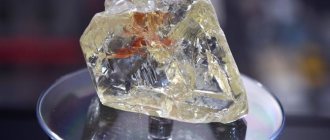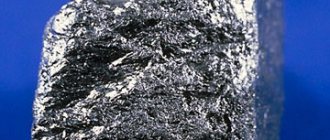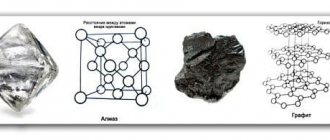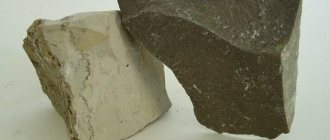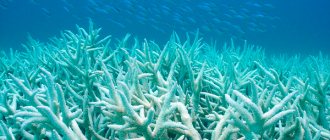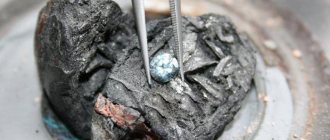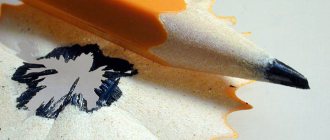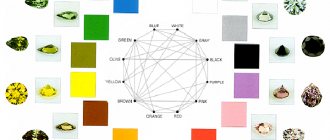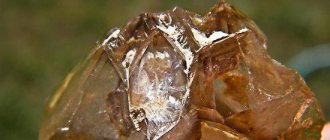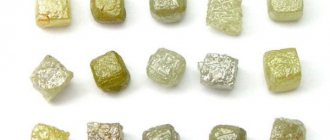Diamond is a mineral that is nothing more than a modification of carbon. A pure diamond has a formula consisting of just one element. The stone has unique properties in nature, so the crystal lattice of diamond has interested scientists, and the structure of the substance continues to be studied.
A perfect diamond can be thought of as a giant carbon molecule. Scientists studied the composition of the mineral only at the end of the 18th century. From that moment on, attempts began to artificially synthesize diamond in laboratories, but they were pointless, since it was impossible to rebuild the crystal lattice from scratch.
Diamond structure
And the technology was not at such a level as to create the conditions for the formation of a diamond. Only in the fifties of the twentieth century were scientists able to synthesize diamond on their own. This was done by countries such as the USSR, the USA and South Africa.
What is a crystal lattice
As you know, all substances consist of particles - atoms, which can be arranged randomly or in a certain order. In amorphous substances, the particles are arranged randomly, while in crystalline substances they form a certain structure. This structure is called a crystal lattice. It determines such characteristics of a substance as hardness, brittleness, boiling and/or melting point, plasticity, solubility, electrical conductivity, etc.
The crystal lattice is the internal structure of a crystal, the order of mutual arrangement of atoms, ions or molecules. The points at which these particles are located are called lattice nodes.
The particles are held in place by chemical bonds between them. Depending on what type of bond holds the atoms or ions of a given substance, the main types of crystal lattices are distinguished in chemistry:
- atomic (covalent bonds),
- molecular (covalent bonds and attraction between molecules),
- metal (metal connections),
- ionic (ionic bonds).
Important!
Do not confuse these two concepts - crystal lattice and chemical bond. The type of lattice indicates how atoms/ions are arranged in a molecule of a substance, and the type of bond indicates the principle by which they interact with each other.
Definition
A crystal lattice is a special structure of a solid substance in which the particles stand in a geometrically strict order in space.
In it you can find nodes - places where elements are located: atoms, ions and molecules and internodal space. Solids , depending on the range of high and low temperatures, are crystalline or amorphous - they are characterized by the absence of a certain melting point. When exposed to elevated temperatures, they soften and gradually turn into liquid form. These types of substances include: resin, plasticine.
This is interesting: hydrogen bond - examples, mechanism of formation.
In this regard, it can be divided into several types:
- atomic;
- ionic;
- molecular;
- metal.
But at different temperatures, one substance can have different forms and exhibit diverse properties. This phenomenon is called allotropic modification.
This is interesting: metals and non-metals in the periodic table of Mendeleev.
Structure and state of aggregation of substances
There are three states of aggregation: solid, liquid and gas. Each of them assumes a certain arrangement of particles. Below we will describe in more detail how the crystal lattice and the aggregative state of a substance are related in chemistry, but for now we will highlight the general principles.
- If the particles move chaotically, and the distance between them is many times greater than their own sizes, it is a gas . Due to the great distance from each other, the molecules and atoms in such a substance weakly interact with each other.
- If the particles are still arranged randomly, but at a small distance from each other, it is a liquid . In the liquid state of a substance, its molecules and atoms have stronger bonds that are more difficult to break.
- If the particles are collected close to each other and in a certain order, it is a solid . In this state, the connections between them are strongest. Particles can only move within their location and hardly move in space.
Most substances can be in a solid, liquid, or gaseous state, and depending on pressure and temperature, they can easily change from one to another. A typical example is water, which turns into steam when heated and becomes solid ice when cooled.
Synthetic diamonds
The discovery of allotropic modifications gave scientists hope for the synthetic production of diamonds. And they partially succeeded, although the process itself cannot be called easy. From a chemical point of view, the same graphite, for example, should receive sigma bonds. Such conditions can only be recreated in the most powerful laboratories under the influence of high temperatures and pressure.
- HPHT is a type of diamond obtained from dissolving graphite and depositing it in a catalyst on a seed mineral. After this, the substance begins to build the necessary connections.
- CVD type - based on film deposition of graphite using methane vapor.
- The explosive synthesis method is the most natural, using carbon under high pressure.
So far, even these methods are difficult to implement, so the cost of diamonds remains high. But technology continues to develop in this direction.
Atomic crystal lattice
According to its name, an atomic crystal lattice is a structure in which atoms are located at the nodes. They interact using covalent bonds, that is, one atom gives another a free electron, or electrons from different atoms form a common pair. In crystals with an atomic lattice, particles are tightly bound, which determines a number of physical characteristics.
Properties of substances with an atomic lattice:
- strength,
- hardness,
- inability to dissolve in water,
- high boiling and melting point.
For example, diamond, the hardest mineral in the world, has an atomic crystal lattice.
Other examples: germanium Ge, silicon Si, boron nitride BN, carborundum SiC. A typical representative of this group is ordinary sand, which is essentially silicon oxide SiO
2.
Lifehack
If you need to talk about the properties of substances with an atomic crystal lattice, it is enough to remember sand and list its characteristics.
Physical and chemical properties
The chemical formula of the mineral is C. The crystal conducts heat well, but does not conduct (or weakly conducts) electric current. Has good refractive and reflective properties.
Melts at temperatures above 3700 degrees. Burns in combination with oxygen at temperatures above 721 degrees. Resistant to acids and alkalis.
Physical properties:
- Color: colorless, transparent. Possible shades of blue, yellow, blue, pink, red, brown, black.
- Shape: crystal with a different number of faces.
- Gloss: strong diamond.
- Density: 3.5 g/cm3.
- Hardness: absolute, 10 points. But the stone is very fragile.
- Cleavage: average.
- Electrical conductivity: weak or absent.
- Luminescent under ultraviolet light.
- Under the influence of X-ray radiation, the bond strength decreases.
Molecular crystal lattice
As in the previous group, this one contains substances with covalent bonds between atoms. But the physical characteristics of these substances are completely different - they easily melt, turn into liquid, and dissolve in water. Why is this happening? The thing is that here crystals are built not from atoms, but from molecules.
A molecular crystal lattice is a structure in whose nodes there are not atoms, but molecules.
Inside molecules, atoms have strong covalent bonds, but the molecules themselves are weakly bonded to each other. Therefore, the crystals of such substances are fragile and easily disintegrate.
The molecular crystal lattice is characteristic of water. At room temperature it is a liquid, but as soon as it is heated to the boiling point (which is relatively low), it immediately begins to turn into steam, that is, it goes into a gaseous state.
Some molecular substances - such as dry ice CO
2, are capable of transforming into gas immediately from the solid state, bypassing the liquid state (this process is called sublimation).
Properties of molecular substances:
- slight hardness;
- low strength;
- fusibility;
- volatility;
- some have an odor.
In addition to water, substances with a molecular crystal lattice include ammonia NH
3, helium He, radon Rn, iodine I, nitrogen
N
2 and others. All noble gases are molecular substances. Most organic compounds (for example, sugar) also belong to this group.
Application of material
The main areas of application of silicon carbide are electronics and energy. This substance is used in the production of semiconductor mechanisms, LEDs, resistors, transistors and energy meters. These devices are highly durable and can function stably for 10 years. They are used in high-frequency electronics. Silicon carbide products have the following properties:
- They have a large band gap;
- Can operate at high temperatures (up to 600 °C);
- They have increased thermal conductivity, unlike devices made of gallium arsenide and other minerals.
- Resistant to radiation and electrical charges.
Due to the high fire resistance and heat resistance of the material, it is actively used in metallurgy and the chemical industry. Many heating devices are made from carborundum solid solution and are capable of operating at high temperatures (up to 2000 °C). These devices can function in neutral or reduced environments. Heating elements are actively used in the heat treatment of metal parts for ceramic devices and electronic components.
Silicon carbide is used as an abrasive due to the high strength and low cost of the chemical compound. In abrasive machining, this material is used in the following processes:
- grinding;
- lamination of paper products;
- sandblasting;
- honing;
- water jet cutting.
Carborundum has found wide application in the production of structural materials. It is resistant to physical stress and is widely used in the manufacture of bulletproof vests and disc brakes installed on vehicles. Since the 1990s Carborundum is used to make durable gas turbines. They are resistant to high temperatures and shock loads.
Ionic crystal lattice
As is known, during an ionic chemical bond, one atom gives ions to another and acquires a positive charge, while the receiving atom becomes negatively charged. As a result, oppositely charged ions appear, which make up the structure of the crystal.
An ionic lattice is a crystalline structure, at the nodal points of which there are ions bound by mutual attraction.
Almost all salts have an ionic crystal lattice; table salt NaCl can be considered a typical representative. It is worth remembering if you need to list the physical characteristics of this group. Also, alkalis and oxides of active metals have an ionic lattice.
Properties of substances with ionic structure:
- hardness;
- fragility;
- infusibility;
- non-volatility;
- electrical conductivity;
- ability to dissolve in water.
Examples of substances with an ionic crystal lattice: calcium oxide CaO, magnesium oxide MgO, ammonium chloride NH
4
Cl
, magnesium chloride Mg
Cl
2, lithium oxide
Li
2
O
and others.
Molecular structure of substances
These are substances made up of molecules. The bonds between the molecules in such substances are very weak, much weaker than between the atoms inside the molecule, and even at relatively low temperatures they break - the substance turns into a liquid and then into a gas (sublimation of iodine). The melting and boiling points of substances consisting of molecules increase with increasing molecular weight. Molecular substances include substances with an atomic structure (C, Si, Li, Na, K, Cu, Fe, W), among them there are metals and non-metals.
